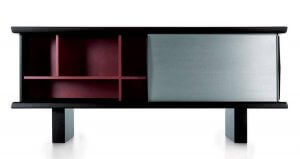Charlotte Perriand and Her Contribution to Modern Design

The age of modern design has given us a number of remarkable designers. One of these is Charlotte Perriand. A visionary designer, she played an active role in the avant-garde movement in the early 20th Century, a time which saw great changes in aesthetic values.
It is thanks to Charlotte Perriand that Le Corbusier’s designs reached the fame and renown that they did. Her modernist vision allowed her to create interiors that complemented the Swiss architect’s iconic buildings.
In a time when occupations such as architects and designers were considered male roles, a female architect was nothing short of ground-breaking. However, this meant that the name of Charlotte Perriand was only known as an assistant at le Corbusier’s studio, rather than for the pioneer that she was.
Nevertheless, she continued to play a fundamental role in modern design, becoming a driving force for the avant-garde movement. Her designs gave le Corbusier’s spaces a unique touch; up until then, they had simply used furniture from other designers.
“What is the crucial element in domestic equipment? We can answer that immediately: storage. Without well-planned storage, it is impossible to find space in one’s home.”
– Charlotte Perriand
Life and career

Perriand was born in Paris in 1903, the daughter of a tailor and a high-end seamstress. In 1920, she enrolled in the Ecole de L’Union Centrale de Arts Decoratifs (School of the Central Union of Decorative Arts) where she studied furniture design for the next five years.
By the end of her studies, Perriand still wasn’t convinced by the style taught at the school, which combined woodcraft with the Beaux-Arts style. As a result, she found inspiration in the machine age aesthetic, and in the motor vehicles and other new machines that were emerging at the time.
By the age of 24, she had started to make a name for herself in the world of design. Her success came as a result of her highly acclaimed Bar sous le Toit (bar under the roof), made of aluminum, glass, and chrome, which she presented at the Salon d’Automne in 1927.
But one of the pivotal moments in Perriand’s life and career came when she first knocked on the door of Le Corbusier’s studio. The first time the young designer visited the studio, le Corbusier told her, “Sorry, but we don’t embroider cushions here”. With these words, he shut the door in her face.
But this didn’t dissuade her. Far from it, in fact. And a month later, after seeing her work on Bar sous le Toit, le Corbusier agreed to hire her. She went on to work alongside le Corbusier and Pierre Jeanneret for more than 1o years.
At Le Corbusier’s studio, Charlotte held the position of Head of Interiors. In 1928, she designed three chairs for the Swiss architect’s studio.
Each of these chairs had a tubular, steel frame. Each had a different purpose; the B301 was a chair for conversation, the LC2 was designed for comfort and relaxation, and the B306 was a chaise longue, designed for sleeping.
Charlotte Perriand – design philosophy

Charlotte believed that her designs should be adapted for the real world and the needs of the people who would one day live in that space. The idea behind her interiors was to make people’s day-to-day lives easier. Bringing beauty and fighting against chaos, there is a distinct sense of freedom to her work.
Taking a great interest in both politics and economics, she didn’t aspire to luxury or the grand houses reserved for the upper classes. On the contrary, conscious of the great significance of that moment in history, she focused on the communist principles that found popularity in that era.
These principles lead her to focus on the development of constructions and designs that were accessible for everyone, or at least, for as many people as possible.
She hoped to change the world, starting with the home. Her interiors were designed to fit into even the smallest of spaces, from social housing to laborers’ homes.
She applied the same principles to the materials used in her designs, choosing only those that were accessible to all. To make her furniture more affordable, she replaced steel and leather with wood and wicker.
Her designs also combined her great interest in modular and prefabricated housing. By uniting these two concepts, she was able to cut costs and make her work more versatile.
Charlotte Perriand – new influences

Nazi occupation of France during the Second World War forced Charlotte to flee, and seek refuge in Japan. The day German soldiers took control of Paris, she left Marseille. But the war followed her to Japan, so she moved again, this time to Vietnam.
These experiences gave her new inspiration for her works, such as Zen Buddhism. With new materials at her disposal, she embarked on the experimental stage of her career.
Perriand died in 1999, at the age of 96. She continued to lead an active life until the very end, publishing her memoirs barely a year before her death. Entitled, “A Life of Creation”, they reveal a life dedicated to the design of spaces and furniture, which continue to be manufactured today.
Charlotte was able to take modern design in a new direction. She liked to take the time to contemplate aspects of form, ergonomics, and function in every space she worked in. For a number of reasons, she lived her life out of the limelight, in the shadow of her colleagues at Le Corbusier’s studio.
The age of modern design has given us a number of remarkable designers. One of these is Charlotte Perriand. A visionary designer, she played an active role in the avant-garde movement in the early 20th Century, a time which saw great changes in aesthetic values.
It is thanks to Charlotte Perriand that Le Corbusier’s designs reached the fame and renown that they did. Her modernist vision allowed her to create interiors that complemented the Swiss architect’s iconic buildings.
In a time when occupations such as architects and designers were considered male roles, a female architect was nothing short of ground-breaking. However, this meant that the name of Charlotte Perriand was only known as an assistant at le Corbusier’s studio, rather than for the pioneer that she was.
Nevertheless, she continued to play a fundamental role in modern design, becoming a driving force for the avant-garde movement. Her designs gave le Corbusier’s spaces a unique touch; up until then, they had simply used furniture from other designers.
“What is the crucial element in domestic equipment? We can answer that immediately: storage. Without well-planned storage, it is impossible to find space in one’s home.”
– Charlotte Perriand
Life and career

Perriand was born in Paris in 1903, the daughter of a tailor and a high-end seamstress. In 1920, she enrolled in the Ecole de L’Union Centrale de Arts Decoratifs (School of the Central Union of Decorative Arts) where she studied furniture design for the next five years.
By the end of her studies, Perriand still wasn’t convinced by the style taught at the school, which combined woodcraft with the Beaux-Arts style. As a result, she found inspiration in the machine age aesthetic, and in the motor vehicles and other new machines that were emerging at the time.
By the age of 24, she had started to make a name for herself in the world of design. Her success came as a result of her highly acclaimed Bar sous le Toit (bar under the roof), made of aluminum, glass, and chrome, which she presented at the Salon d’Automne in 1927.
But one of the pivotal moments in Perriand’s life and career came when she first knocked on the door of Le Corbusier’s studio. The first time the young designer visited the studio, le Corbusier told her, “Sorry, but we don’t embroider cushions here”. With these words, he shut the door in her face.
But this didn’t dissuade her. Far from it, in fact. And a month later, after seeing her work on Bar sous le Toit, le Corbusier agreed to hire her. She went on to work alongside le Corbusier and Pierre Jeanneret for more than 1o years.
At Le Corbusier’s studio, Charlotte held the position of Head of Interiors. In 1928, she designed three chairs for the Swiss architect’s studio.
Each of these chairs had a tubular, steel frame. Each had a different purpose; the B301 was a chair for conversation, the LC2 was designed for comfort and relaxation, and the B306 was a chaise longue, designed for sleeping.
Charlotte Perriand – design philosophy

Charlotte believed that her designs should be adapted for the real world and the needs of the people who would one day live in that space. The idea behind her interiors was to make people’s day-to-day lives easier. Bringing beauty and fighting against chaos, there is a distinct sense of freedom to her work.
Taking a great interest in both politics and economics, she didn’t aspire to luxury or the grand houses reserved for the upper classes. On the contrary, conscious of the great significance of that moment in history, she focused on the communist principles that found popularity in that era.
These principles lead her to focus on the development of constructions and designs that were accessible for everyone, or at least, for as many people as possible.
She hoped to change the world, starting with the home. Her interiors were designed to fit into even the smallest of spaces, from social housing to laborers’ homes.
She applied the same principles to the materials used in her designs, choosing only those that were accessible to all. To make her furniture more affordable, she replaced steel and leather with wood and wicker.
Her designs also combined her great interest in modular and prefabricated housing. By uniting these two concepts, she was able to cut costs and make her work more versatile.
Charlotte Perriand – new influences

Nazi occupation of France during the Second World War forced Charlotte to flee, and seek refuge in Japan. The day German soldiers took control of Paris, she left Marseille. But the war followed her to Japan, so she moved again, this time to Vietnam.
These experiences gave her new inspiration for her works, such as Zen Buddhism. With new materials at her disposal, she embarked on the experimental stage of her career.
Perriand died in 1999, at the age of 96. She continued to lead an active life until the very end, publishing her memoirs barely a year before her death. Entitled, “A Life of Creation”, they reveal a life dedicated to the design of spaces and furniture, which continue to be manufactured today.
Charlotte was able to take modern design in a new direction. She liked to take the time to contemplate aspects of form, ergonomics, and function in every space she worked in. For a number of reasons, she lived her life out of the limelight, in the shadow of her colleagues at Le Corbusier’s studio.







